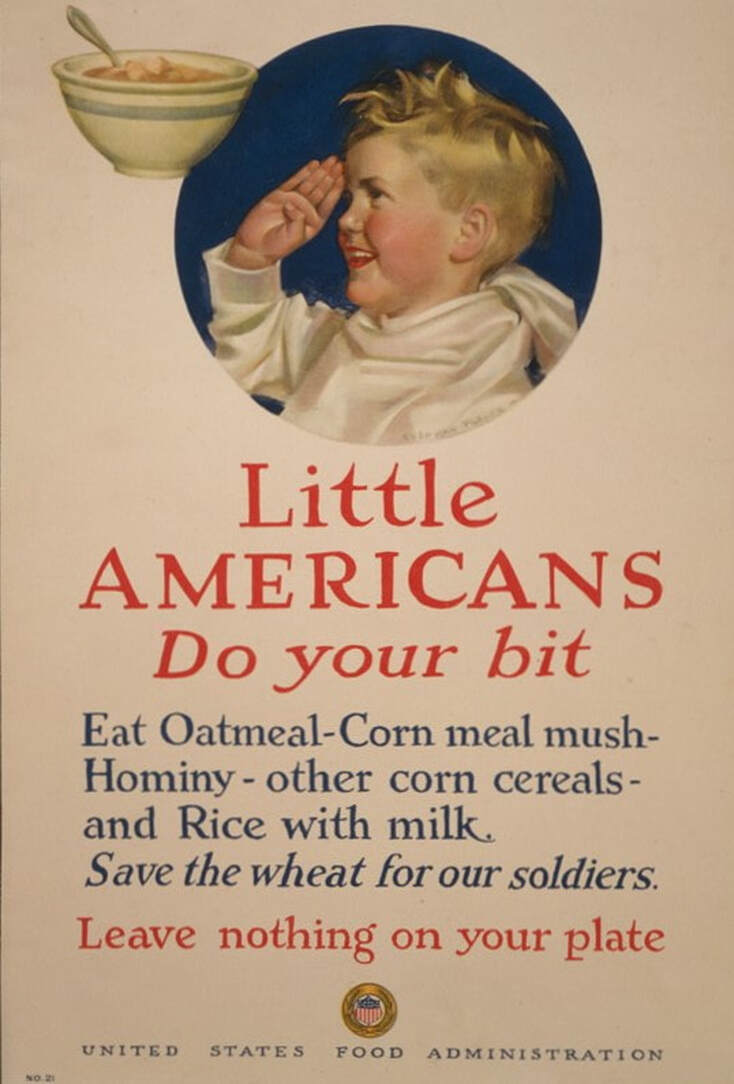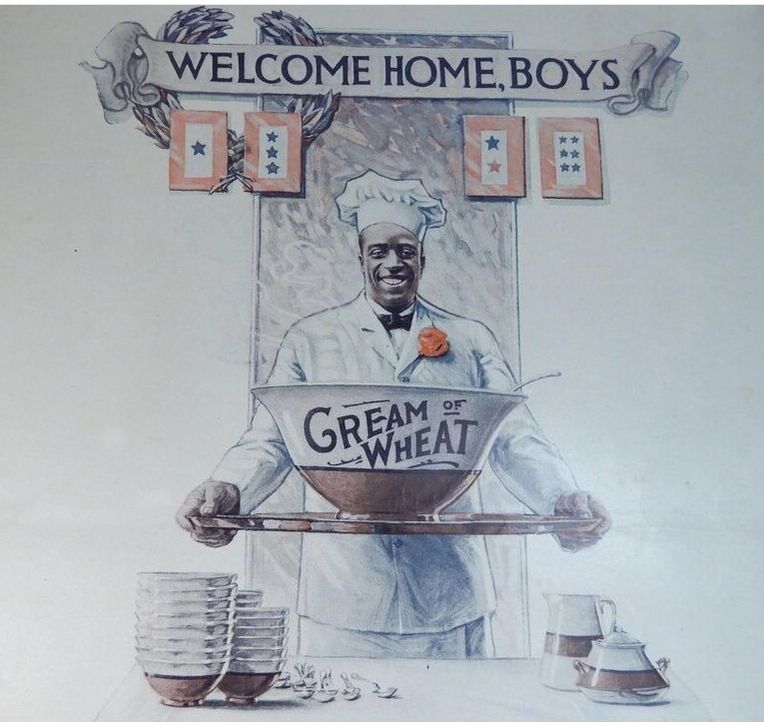|
I was interviewed recently about breakfast cereals, especially corn flakes and the Kellogg brothers, so I thought for this week's World War Wednesday we'd take a look at this sweet propaganda poster from the First World War. "Little Americans - Do Your Bit! Eat Oatmeal - Corn meal mush - Hominy - other corn cereals - and Rice with milk. Save the wheat for our soldiers. Leave nothing on your plate" was designed by commercial artist Cushman Parker, who also designed covers featuring cherubic children for the Saturday Evening Post. This poster is interesting because the message is targeted specifically at children. Aside from the school garden movement, there weren't many food-related wartime posters directed to kids - this is one of the only ones. In this poster, a rosy-cheeked blond young man - who looks to be about five or six years old, salutes a floating bowl of hot cereal, a large white napkin tied around his neck as a bib. Although cold breakfast cereals were around at the time of the First World War, they were still considered less nourishing than hot cereals, especially for children. Oatmeal, Cream of Wheat (a.k.a. farina or semolina), and cornmeal or hominy mush were still popular at the breakfast table. Wheat was in short supply during the First World War, so ordinary Americans were encouraged to voluntarily restrict use to free up supplies for American soldiers and the Allies. That meant no more farina! As was true of much of the wartime propaganda, this poster calls for Americans to support the soldiers, doing without so "the boys over there" could have enough. Although Americans only entered the war in the spring of 1917, and it was over by the fall of 1918, wheat supplies continued to tighten throughout the war. By shifting eating habits to focus on other hot cereals, especially oatmeal and corn products like grits, Americans could help "do their bit" for the war effort. Rationing was voluntary for Americans, but Meatless Mondays and Wheatless Wednesdays still came to dominate American daily life. And children were no exception! Although advertising usually targeted the person who did the food shopping (usually the mother), this poster stands out as one targeting children directly, likely to help educate them about the needs of American troops and cut down on potential complaining, which might encourage parents to give into whining and purchase wheat products. The return of wheat, sugar, meat, and fats like butter and lard were a welcome herald to the end of the war. In this 1919 magazine advertisement, Rastus, the racist depiction of an African American cook used by Cream of Wheat packaging and advertisements for over 100 years before finally being removed in the fall of 2020, welcomes home American troops with an enormous bowl of Cream of Wheat - a sign of the end of rationing and likely an attempt to return Cream of Wheat to the tables of Americans who might have gotten used to eating other alternatives. The Food Historian blog is supported by patrons on Patreon! Patrons help keep blog posts like this one free and available to the public. Join us for awesome members-only content like free digitized cookbooks from my personal collection, e-newsletter, and even snail mail from time to time! Don't like Patreon? Leave a tip!
2 Comments
jillian pykechartrand
5/25/2022 10:59:47 pm
So interesting . I had a children's class assignment from WWII , the children madr a war magazine . In it , the propaganda for victory gardens were very strong ...there was also an illustration of a cherub like child included ....along with other non food pages such as identifying war planes. It was a greta piece and I donated it to a local hisoltory class .
Reply
5/31/2022 04:17:31 am
Food will accomplish the war! The U.S. Food Administration announced. Guiding the folks at home to curtail on their wheat and meat consumption meant more food to give the soldiers overseas. But, what about the folks who resides at the stateside? Distribution of goods on the home front actually notably will not start until World War II, but the Wilson administration and then-United States Food Administration leader Herbert Hoover utilized a range of conflicting information to lessen the national intake of the meat and bread required to deliver to the 4 million troops overseas. They encouraged the people at home that “Food Will accomplishes the War.
Reply
Your comment will be posted after it is approved.
Leave a Reply. |
AuthorSarah Wassberg Johnson has an MA in Public History from the University at Albany and studies early 20th century food history. Archives
July 2024
Categories
All
|



 RSS Feed
RSS Feed